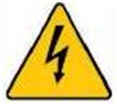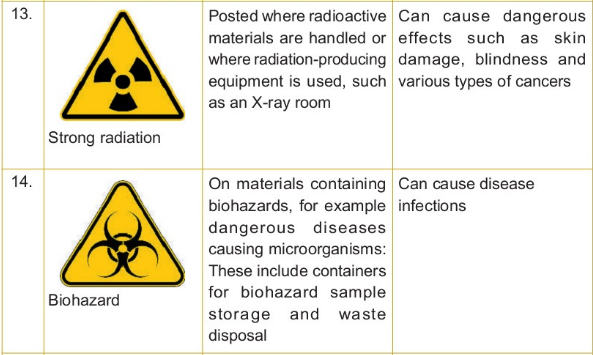Chapter 01 : Safety signs in the environment
Introduction in Standard Six, you learnt about environmental cleanliness. In this chapter, you will learn about the concept of safety signs in the environment, interpretation Of safety signs and uses Of safety signs in the environment The competencies gained enable you to take appropriate precautions in ensuring your safety and that of others.
The concept of safety signs
| Think 1. Safety signs available in your environment 2. Places where the safety signs are positioned 3. The meaning and importance of safety signs |
In our environment, there are signs or symbols that give signals or warning. These are known as safety signs. Safety signs provide information about dangers in items or the environment. Likewise, safety signs provide instructions that can lead to the protection of living and non-living organisms in the environment, Some safety signs are presented with texts to facilitate interpretation. However, most of the signs and symbols have no texts. Users in the relevant areas are supposed to understand the meaning of the signs. Safety signs are used in all countries, and they are placed on items such as bottles containing medicines or chemicals. They are also placed on vehicles and vessels such as buses, airplanes, ships, boats and fuel tankers, Similarly, they are placed on buildings to indicate slippery floors and exit during emergencies. They are also placed on items with chemicals or potential hazards. In addition, these safety signs are placed on transformers and electric poles With high voltage, Safety Signs are important because they help us to take appropriate precautions when using Such items and equipment, They also warn us against risky environments, such as playing or passing across high voltage cables.
Types of safety signsThere are four major types of safety signs, which are
(a) prohibition,
(b) warning,
(c) mandatory, and
(d) emergency.
Each type of the safety signs is presented in a specific shape and color. The shapes and colours of the signs are governed by the international safety regulations as shown in Table 1
Table 1 Types or safety Signs, their colors, instructions, arid Characteristics
| S/N | Types Of Sign | Color | Instructions | Characteristics | Example |
| 1. | Prohibition signs | Red | (a) Danger (b) Stop (c) Turn off or shutdown (d) Vacate (e) No entry for unauthorized person | Red circle or quadrilateral (rectangular or square), black image on a white background and red border. Some of these signs have a red diagonal line through them. |  |
| 2. | Warning signs | Yellow | (a) Be careful (b) Take precaution (c) Danger nearby | Triangular, a black image on a yellow background and a black border |  |
| 3. | Mandatory signs | Blue | Insisting specific behavior or actions | Circular, a white image on a blue background |  |
| 4. | Emergency signs | Green | (a) Emergency exit door (b) Emergency exit (c) First aid or rescue facilities | Rectangular or square, white image or text on a green background or green image or text on a white background |  |
Note: Some of the safety signs are presented using different colors depending on the degree of potential effects in case the precaution is not taken. For example, danger signs may have red, orange or yellow colors. The red colour indicates major effects followed by orange and yellow colours The danger sign is used in places that can cause severe injuries or death in case precautions are not taken. A danger sign with a red background and white text is used to indicate environmental hazards which can cause major effects.
The interpretation of safety signs
Safety signs offer precautions to users. It is important to recognize these signs and their meanings. This will help to avoid the possible dangers or accidents which may occur by ignoring the given precautions. Table 2 shows some Of the safety Signs,
Table 2. Interpretation of some safety signs

|
| Activity Materials: manila papers, marker pens, pencils and colored pencils Procedure1. Visit places having safety signs and study the signs. 2. Draw the signs on manila paper. Questions(a) Which of the items or equipment that you saw had safety signs? (b) What are the safety signs you saw on the items or in the different places that you visited? (c) What are the possible effects a person can get if he or she does not follow the instructions of the signs? |
Exercise
Answer the following questions:
1. Give the meaning of safety signs.
2. Why are there different safety signs in the environment?
3. Why are texts included in some safety signs?
4.Use Table 3 to write the appropriate interpretations of the indicated safety signs.
Table 3: Safely signs and interpretation

|
Uses Of safety Signs in the environment
Safety signs are used in different places and on items available in our environment. The following are some of the uses of safety signs:
Indicating danger
There are items or places marked with safety signs to caution people against the possible dangers in case they do not take precautions, For example, some safety signs indicate the risks of X-ray radiation, explosive chemicals, and a high voltage transmission line. These signs require a person to take precautions as he or she approaches such environments.
Prevention of diseases
Safety signs are used to indicate ways in which a person can be protected from diseases or health effects by adhering to the given safety signs. For example, safety signs on bio-hazardous items such as waste dustbins in hospitals warn us against touching. This sign protects one from the diseases caused by bio-hazards.
Prevention of accidents
Some safety signs can help to prevent accidents. For example, a fuel tanker has a waming sign for highly flammable materials. Therefore, this sign is used to prevent possible fire accident
Warning and instructions
Some safety signs alert and provide instructions on how to use items or do something carefully For example, easily broken items are marked with instructions such as "handle with care" to help carry them safely. Some chemicals such as insecticides or herbicides are marked as dangerous or toxic. The signs on those chemicals require the user to wear protective equipment to use them safely. Such protective items include gloves, goggles, special clothing or overalls, boots and helmets. The flammable safety sign is placed on bottles containing pesticides and perfumes. Therefore, it is advised to stay away from fire sources when using such items.
Vocabulary
Explosive : a substance that is able or likely to cause an explosion
pesticide : a substance or chemical used to control or kill organisms that affect plants, animals, or products
X-ray radiation : an electromagnetic radiation Of high energy and very short wavelength which is able to pass through materials that are opaque to light
Exercise
Answer all questions in Sections A and B.
Section A: Choose the most correct answer and write its letter in the box provided.
1. The types of safety signs are
- prohibition, warning, mandatory, and emergency signs
- emergency, personal, and danger signs
- mandatory, prohibition, and entry signs
- hospital, warning, road, and aerial signs
2. What is the colour used for mandatory signs?
- Yellow
- Red
- Blue
- Green
3. What does the following sign represent?
- Toxic
- Flammable
- Corrosive
- Harmful
4. One of the following words is not displayed on pesticide containers.
- Flammable
- Toxic or danger
- Unsafe water
- Irritant
5. What precaution should you take to protect your eyes when using dangerous items?
- Wear a mask
- Use a face cloth
- Wear a hat
- Wear goggles
Section B
6. List four uses of safety signs.
7. List five items or equipment with danger or toxic signs.
8. Explain five precautions that you will take when using drugs or chemicals having a toxic sign.
9. Explain the importance of safety signs.
10. Explain the possible effects which can occur when using chemicals with the irritant sign.
www.learninghubtz.co.tz
Hub App
 For Call,Sms&WhatsApp: 255769929722 / 255754805256
For Call,Sms&WhatsApp: 255769929722 / 255754805256
 For Call,Sms&WhatsApp: 255769929722 / 255754805256
For Call,Sms&WhatsApp: 255769929722 / 255754805256
WHATSAPP US NOW FOR ANY QUERY
App Ya Learning Hub Tanzania



















